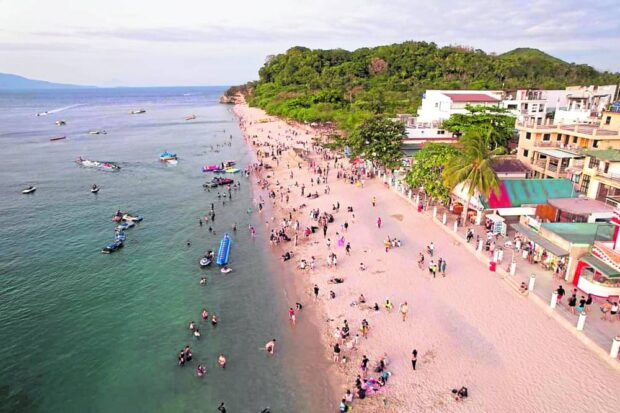Despite poor water quality, Puerto Galera to stay open

SUN AND SEA | Puerto Galera’s famous White Beach plays host to hundreds of tourists enjoying the sun and sand in this photo taken on March 29, 2023. It will remain open despite the poor water quality test results and the threat of an oil spill from the sunken MT Princess Empress. (Photo from the Mangyan Travel Vlog)
MANILA, Philippines — Only nine out of 35 sampling stations in the municipality of Puerto Galera, the top tourist destination in Oriental Mindoro province, passed the water quality test conducted by the Department of Environment and Natural Resources (DENR).
Environment Undersecretary Jonas Leones, at a press briefing on Tuesday, reminded the public to be cautious as contact with the contaminated water could result in skin diseases, rashes, or blisters.
In a joint statement with the Department of Health (DOH), the DENR on Tuesday said the areas that met the water quality test were the Small Lalaguna and Big Lalaguna shorelines, Balete, Central Sabang shoreline, Coco Beach, Batangas Channel, Paniquian, Balatero, and West San Isidro Bay.
Leonas stressed that the results of the test, which analyzed the oil and grease contaminants, were not yet conclusive on whether the poor water quality in the 26 other stations could be attributed to the oil spill that hit Oriental Mindoro after oil tanker MT Princess Express sank in its waters with 800,000 liters of industrial fuel on Feb. 28.
“A study is needed to further analyze the water quality because based on our data results, the water quality in those areas in Puerto Galera was not good even before [the oil spill],” he said.
Article continues after this advertisementLeones pointed out that even if Puerto Galera’s water was clear, it might still be contaminated.
Article continues after this advertisementEnvironment Secretary Maria Antonia Yulo-Loyzaga, in the same briefing, was optimistic that the government would be able to contain the oil spill off Oriental Mindoro within the month.
“When it comes to the waters on the shoreline, we will continuously test for the presence of any kind of contaminants and we will be there I think much longer than other agencies because the ecosystem impacts are actually long-term,” Yulo-Loyzaga said.
Exercise caution
Based on the DENR’s water quality tests, the DOH has warned against the health hazards of water contamination.
“In the interest of public health and safety, the DOH advises the public to exercise caution and refrain from consuming water from affected areas and when conducting water-related occupational (e.g. fishing, seaweed farming) and recreational activities,” the DOH said in its joint statement with the DENR.
“The public is also advised to avoid consumption of contaminated fish, shellfish and other seafood products,” it added, stressing that water with “detectable levels of contaminants beyond the standards” are unfit for consumption.
The DOH said exposure to contaminants could not only lead to skin diseases but “oils and grease may also result in aspiration leading to respiratory diseases while ingestion will cause gastrointestinal irritations which may manifest acutely as abdominal pain, nausea, vomiting and diarrhea.”
To stay open
However, Tourism Secretary Christina Frasco on Tuesday said Puerto Galera would continue to be open for tourism despite the water quality test results, warning that Oriental Mindoro would lose P5.3 million daily if tourists would be barred from entering its top travel destination.
“Should Puerto Galera be closed to tourism, there is a projected loss of … at least P5.3 million a day,” Frasco told reporters at a Palace briefing.
Frasco stressed that even if only nine of the 35 sampling stations passed the water quality test, these areas were “very prime dive sites for Puerto Galera.”“We are also pleased to receive the Department of Health’s position that the public is advised to proceed with caution but that no swimming ban has been indicated, only that concerns have been expressed in the ingestion of water,” she said. “And, therefore, our perception of this joint statement is that the Puerto Galera tourism continues to be open, as well as that there has been no direct attribution in terms of the direct source of the findings considering the presence of other human and economic activities in Puerto Galera.”
According to Frasco, Puerto Galera is contributing at least 85 percent of the tourism economy of the province, noting that during its peak before the pandemic, Puerto Galera generated tourism receipts of over P1.2 billion.
“Notwithstanding the fact that the Philippines only reopened in February of last year, Puerto Galera had already raked in half a billion pesos,” she said.
“So, what is critical really right now is the protection not just of life but also of the livelihood of the tourism workers that critically depend on the continuation of the tourism industry,” she added.